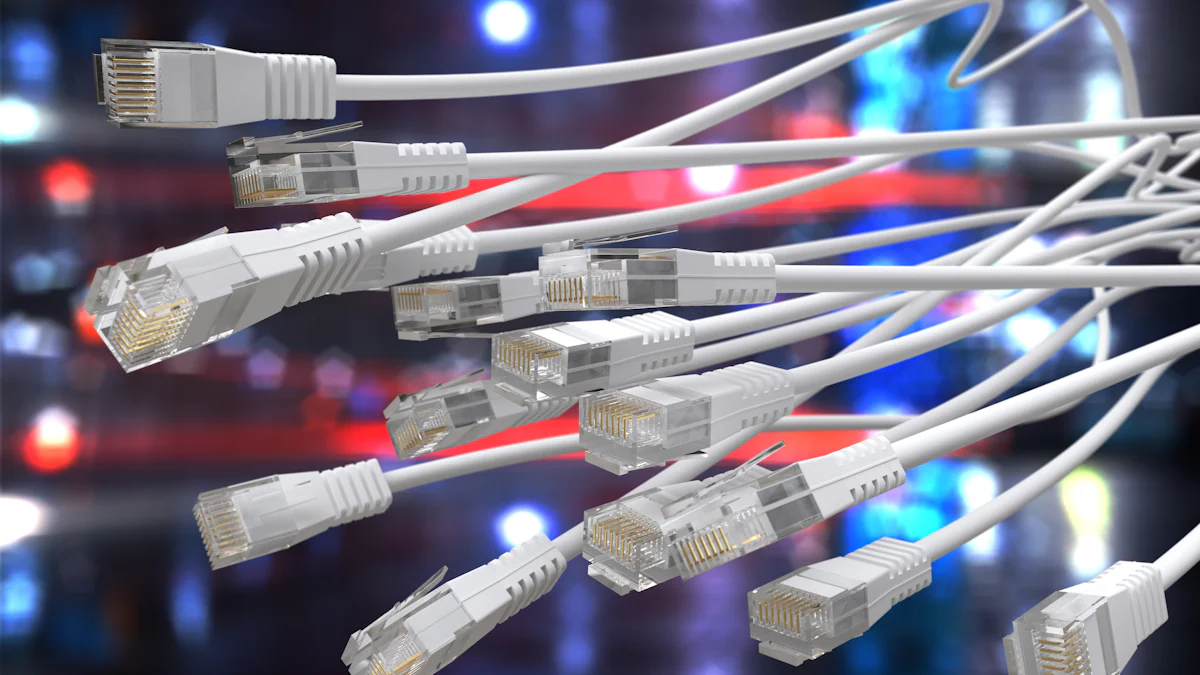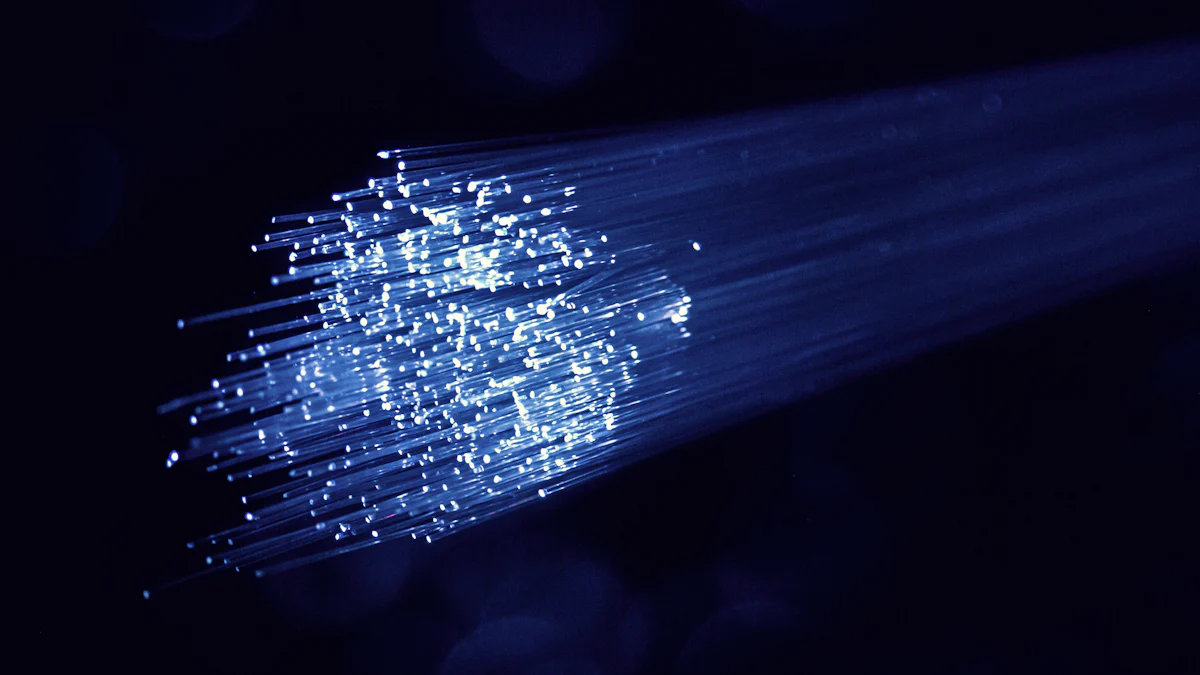5 Breakthroughs in Fiber Optic Fast Connector Technology
Fiber Optic Connectors play a crucial role in modern communication networks, accounting for over 17% of the total share in the fiber optic components market. These connectors efficiently join optical fibers to transmit information across various sectors like security, telecommunication, and data centers. As technology advances, so do these connectors, enabling faster and more reliable connections. In this blog, we delve into the advancements in Fiber Optic Fast Connector technology, highlighting five groundbreaking developments that are shaping the future of Optical Communication. These innovations are pivotal in enhancing the efficiency and reliability of the Fiber Optic Network, leveraging Fast Connection Technology to meet the growing demands of high-speed data transfer.
Enhanced Fiber Optic Fast Connector Design

When it comes to Fiber Optic Fast Connectors, the focus on Enhanced Durability is paramount for ensuring long-lasting and reliable connections. This is achieved through continuous Material Innovations that enhance the robustness of the connectors, making them more resistant to environmental factors and physical stress. Additionally, advancements in Enhanced Manufacturing Processes have streamlined production, resulting in connectors that are not only durable but also consistently high in quality.
In terms of Better Performance, the key lies in minimizing Signal Loss and maximizing Bandwidth. By reducing signal loss within the connectors, data transmission becomes more efficient and reliable. Simultaneously, increased bandwidth allows for higher volumes of data to be transmitted seamlessly across networks, meeting the ever-growing demands for faster communication speeds.
The combination of improved durability and enhanced performance in fiber optic fast connectors signifies a significant leap forward in optical communication technology. These breakthroughs pave the way for more resilient and efficient fiber optic networks that can support the increasing demands of modern communication systems.
Advanced Fiber Optic Network Integration
In the realm of Fiber Optic Network integration, achieving Seamless Connectivity is paramount for ensuring efficient data transmission. The advent of Plug-and-Play Solutions has revolutionized network setup by allowing for quick and hassle-free installations. These solutions eliminate the need for complex configurations, enabling a straightforward connection process that saves both time and resources.
Simplifying installation procedures further enhances the usability of fiber optic networks. By streamlining the setup process, organizations can swiftly deploy communication systems without extensive training or technical expertise. This simplicity not only reduces operational costs but also accelerates network expansion, facilitating rapid deployment in various environments.
Moving towards Network Scalability, the focus shifts to accommodating future growth and technological advancements. Embracing Modular Designs enables networks to expand seamlessly as demands increase. These designs allow for incremental upgrades without disrupting existing infrastructure, providing a flexible framework that can adapt to evolving requirements with ease.
Future-proofing networks is essential in a rapidly changing technological landscape. By integrating technologies that anticipate future needs, organizations can stay ahead of the curve and remain competitive in the market. Implementing strategies for Future-Proofing involves adopting scalable solutions, investing in innovative technologies, and maintaining a forward-looking approach to network development.
The convergence of seamless connectivity and scalable network designs marks a significant advancement in fiber optic technology integration. These breakthroughs not only enhance operational efficiency but also lay the foundation for sustainable growth and innovation in optical communication networks.
Innovations in Fast Connection Technology
In the realm of Fast Connection Technology, the emphasis lies on expediting deployment processes to meet the escalating demands for high-speed data transfer. The evolution in this field has been instrumental in revolutionizing how fiber optic networks are established and maintained, ensuring swift and efficient connectivity across various sectors.
Speed of Deployment
Quick Assembly Techniques
Implementing Quick Assembly Techniques has significantly reduced the time required to set up fiber optic connections, catering to the pressing need for rapid network deployment. By streamlining assembly procedures, organizations can swiftly establish communication channels without compromising on quality or reliability. These techniques involve innovative approaches that simplify the installation process, enabling seamless integration of fiber optic connectors within diverse network infrastructures.
Pre-terminated Solutions
The introduction of Pre-terminated Solutions has further expedited deployment timelines by providing ready-to-use connectors that eliminate the need for on-site termination. These solutions come pre-configured with precision, ensuring optimal performance upon installation. By leveraging pre-terminated connectors, organizations can accelerate network rollout initiatives, saving valuable time and resources while maintaining high standards of connectivity.
Reliability
Consistent Performance
Ensuring Consistent Performance is essential in guaranteeing reliable data transmission across fiber optic networks. The advancements in fast connection technology have led to connectors that deliver consistent performance levels under varying operational conditions. By prioritizing reliability, organizations can mitigate potential disruptions and maintain seamless communication channels critical for their operations.
Robust Testing Protocols
The implementation of Robust Testing Protocols plays a pivotal role in verifying the integrity and functionality of fast connectors before deployment. Through rigorous testing procedures, organizations can identify and rectify any potential issues, ensuring optimal performance and longevity of the network infrastructure. These protocols encompass comprehensive assessments that validate the efficiency and reliability of fast connectors, instilling confidence in their operational capabilities.
According to insights from CXOs of leading companies, there is a growing demand for high bandwidth driven by cloud applications, video services, TV-on-Demand, and online gaming. Fiber optic connectors offer enhanced bandwidth capacity, increased dependability, agility, and security—making them indispensable across various industries such as telecommunications, healthcare, energy utilities, transportation, oil & gas.
Increasing consumer preference for Fiber Optic Connector solutions underscores their effectiveness and convenience. As awareness grows among individuals and businesses regarding the benefits of these connectors—efficiency being paramount—the market anticipates a substantial surge in demand leading to overall growth.
Breakthroughs in Optical Communication

In the realm of Optical Communication, advancements have propelled the field towards achieving unparalleled High-Speed Data Transfer capabilities. This breakthrough is pivotal in meeting the escalating demands for swift and efficient transmission of information across vast networks.
Low Latency
The concept of Low Latency has revolutionized data transfer speeds, ensuring minimal delays in signal transmission. By optimizing network protocols and enhancing signal processing efficiency, organizations can achieve near-instantaneous data delivery, critical for real-time applications such as video conferencing, online gaming, and financial transactions.
High Throughput
High Throughput signifies the capacity to handle substantial volumes of data seamlessly within a specified timeframe. This advancement enables networks to process massive datasets efficiently, supporting bandwidth-intensive applications like high-definition video streaming and cloud computing services. By maximizing throughput capabilities, organizations can enhance operational efficiency and deliver superior user experiences.
In parallel, addressing the challenges of Long-Distance Communication has been a focal point in advancing optical communication technologies. Innovations aimed at extending communication reach while maintaining signal integrity have paved the way for enhanced connectivity across global networks.
Signal Amplification
The integration of Signal Amplification technologies has significantly extended the range of optical communication systems, enabling data transmission over extensive distances without compromising signal strength. By amplifying signals at strategic intervals along fiber optic cables, organizations can overcome attenuation challenges and ensure reliable communication links spanning thousands of kilometers.
Error Correction Technologies
The implementation of Error Correction Technologies has bolstered the resilience of optical communication networks against data loss or corruption during transmission. These technologies employ sophisticated algorithms to detect and rectify errors in real-time, ensuring data integrity across long-haul connections. By mitigating potential disruptions caused by signal degradation or environmental factors, error correction technologies uphold the reliability and accuracy of transmitted information.
Scientific research findings highlight the significance of these breakthroughs in enhancing optical communication capabilities globally. Studies emphasize that advances like multicore fibers, hollow-core fibers, and space-division multiplexing aim to increase data transmission capacity even further. Fiber optics form the backbone of high-speed telecommunications networks, enabling the transmission of vast amounts of data over long distances with minimal signal loss. The global Single Mode Fiber Optic Connectors Market is expected to grow at a CAGR of over 8% during the forecast period due to increasing demand for high-speed data transmission and communication networks.
Factors driving the fiber optic cable and component market include increased reliability, greater bandwidth, enhanced security measures among others. One leading factor propelling market growth is the rising demand for high bandwidth solutions across various industries such as telecommunications, healthcare, energy utilities, transportation, oil & gas.
Embracing these breakthroughs in optical communication technology not only enhances network performance but also sets a foundation for future innovations in high-speed data transfer and long-distance connectivity. By leveraging advancements in low latency, high throughput capabilities alongside signal amplification and error correction technologies, organizations can establish robust communication infrastructures that cater to evolving technological demands seamlessly.
Corning Anaerobic-Cured Connectors
Field Termination Solutions
Corning Anaerobic-Cured Connectors offer innovative Field Termination Solutions that streamline the installation process, ensuring ease of use and time efficiency. These connectors are designed to simplify the termination of fiber optic cables in field applications, eliminating the need for complex tools or extensive training. By incorporating user-friendly features, such as intuitive interfaces and straightforward procedures, organizations can expedite network setup without compromising on quality or reliability.
Ease of Use
The Ease of Use associated with Corning Anaerobic-Cured Connectors enhances operational efficiency by providing a hassle-free termination experience. Users can quickly familiarize themselves with the connector's interface, reducing the learning curve typically associated with traditional termination methods. This simplicity not only accelerates deployment timelines but also minimizes the risk of errors during installation, ensuring consistent performance across fiber optic networks.
Time Efficiency
Time Efficiency is a key advantage offered by Corning Anaerobic-Cured Connectors, enabling rapid deployment of fiber optic connections in various environments. The connectors' efficient design and straightforward termination process significantly reduce installation times, allowing organizations to establish communication channels swiftly and effectively. By optimizing time management during network setup, businesses can enhance productivity and meet project deadlines efficiently.
Optical Performance
Corning Anaerobic-Cured Connectors are renowned for their exceptional Optical Performance, characterized by high precision and consistent quality. These connectors undergo rigorous testing protocols to ensure optimal light transmission and signal integrity, critical for maintaining reliable communication links within fiber optic networks.
High Precision
The High Precision of Corning Anaerobic-Cured Connectors guarantees accurate alignment of optical fibers, minimizing signal loss and maximizing data transmission efficiency. The connectors' precise construction ensures that light signals pass through the fibers without disruptions or distortions, facilitating seamless communication across network infrastructures.
Consistent Quality
Corning Anaerobic-Cured Connectors uphold Consistent Quality standards throughout their lifecycle, from manufacturing to deployment. Each connector undergoes stringent quality control measures to verify its performance under varying conditions. By maintaining consistent quality levels, these connectors deliver reliable connectivity that meets industry standards and surpasses expectations for optical communication networks.
Recap of the Five Breakthroughs:
Enhanced durability and performance in fiber optic fast connectors ensure reliable data transmission.
Seamless network integration and scalable designs facilitate rapid deployment and future-proofing.
Innovations in connection technology expedite high-speed data transfer with enhanced reliability.
Optical communication advancements enable low-latency, high-throughput, long-distance connectivity.
Corning Anaerobic-Cured Connectors offer field-termination solutions with exceptional optical performance.
Impact on the Future of Fiber Optic Technology:
Fiber optic technology's continuous evolution meets market demands for high-speed connectivity.
Ongoing innovations drive growth, making fiber optics the standard for efficient data transmission.
Final Thoughts on Continuous Innovation:
Embracing innovation is crucial for staying ahead in the dynamic landscape of optical communication.
Advancements in fiber optic fast connectors pave the way for enhanced network capabilities and sustainable growth.
See Also
Exploring Epoxy-Free and Quick Connectors for Field Fiber Optic Assembly
Decoding the 2.0 x 5.0mm 1FO Mini SC FastConnect Enhanced Field Connector for SM G657.A2 Fiber
Addressing Fiber Connection Hurdles with 2.0×5.0mm SC UPC Single-Mode Field Optical Connectors
Essential Characteristics of Fiber Optic Adapters and Connectors for Technicians
Mastery of Fiber Optic Communication: Utilizing Nylon Cables for FTTR


